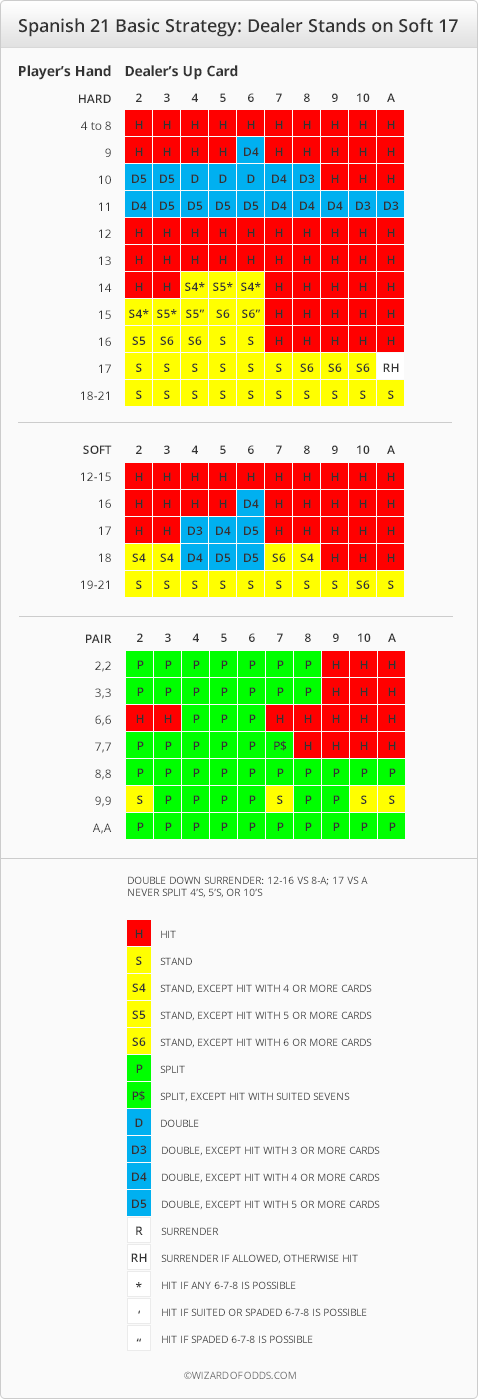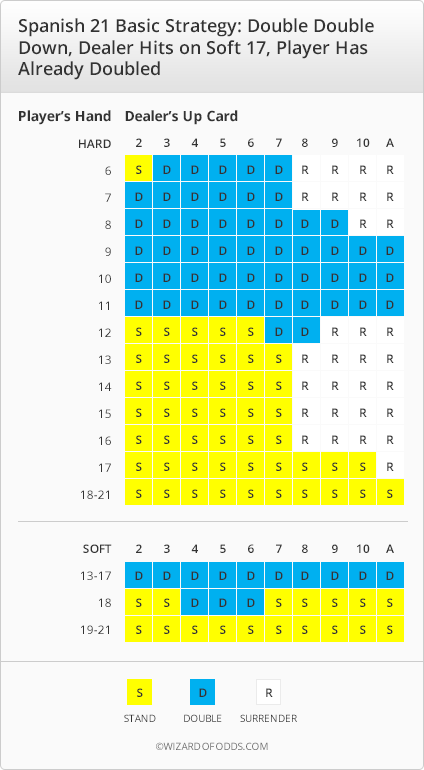On this page
Spanish 21
Introduction
Spanish 21 is a unique twist on traditional blackjack that can sometimes yield better odds for players. In scenarios where the dealer stands on a soft 17, or if redoubling is permitted, Spanish 21 might provide greater benefits compared to blackjack depending on the specific rules in place. If you're interested in stepping away from conventional blackjack yet still enjoy a game with a favorable house edge, Spanish 21 could offer an exciting alternative.
In Australia and Malaysia, Spanish 21 is known as Pontoon. It is important to note that the rules differ slightly in Australia, which deserve a dedicated page to explain. For more information, please visit my page on Australian Pontoon . Adding to the confusion, there exists another game that is quite similar yet distinct enough to warrant its own separate page, referred to as Player's Edge 21 .
Here is a compilation of recognized alternative names for the game:
- Betsoft , a leading software provider for online casinos, markets Spanish 21 under the name Pirate 21.
- In Casino Bregenz, located in Austria, the game is rebranded as Blackjack Exchange.
- The Seven Cedars casino in Washington state refers to it as Bahama Bonus Blackjack.
The Rules
Spanish 21 utilizes six or eight decks of Spanish cards, each containing 48 cards—omitting the four tens from the typical 52. Any card counter will confirm that excluding ten-point cards impacts the odds, making the dealer's position much stronger. To balance this, Spanish 21 introduces various bonuses and rules favorable to players. While Spanish 21 games are widespread across the United States, the rules may slightly vary in different establishments, but commonly favor the player in the following ways:
- Late surrender allowed.
- Double after split allowed.
- Re-splitting aces allowed.
- A player 21 always wins.
- A player’s blackjack wins against the dealer’s blackjack.
- Players are allowed to double down on any amount of cards.
- Typically, players can hit and double after splitting aces.
- Players have the option to surrender after doubling, a feature known as 'double down rescue,' where they forfeit a sum equal to their initial bet.
- A five-card 21 pays out at 3 to 2, a six-card 21 pays at 2 to 1, while a 21 formed with seven or more cards pays at 3 to 1. This bonus isn't available after doubling.
- A 6-7-8 or 7-7-7 of mixed suits pays 3 to 2; the same suit pays 2 to 1, and spades pay 3 to 1. These bonuses also do not apply after doubling.
- If a suited 7-7-7 appears while the dealer shows a seven, it awards a $1000 payout for bets from $5 to $24, and a $5000 'Super Bonus' for wagers of $25 or more. Additionally, each other player earns a $50 'envy bonus.' This bonus is not available after doubling or splitting.
Variable Rules
- Dealer may hit or stand on a soft 17.
- 6 or 8 Spanish decks can be used.
- Certain casinos may permit the option to redouble, up to three times.
- While I've heard of some casinos that don’t allow surrender or drawing to split aces, it's not commonly enforced.
- At least one casino has been noted to treat a face card and ace resulting from a split as a blackjack.
- There has been considerable discussion over the years regarding whether bonuses can be claimed after a split. While it is nearly universally accepted that they do not apply after doubling, the design intent of the game suggests that all bonuses, except for the Super Bonus, should be payable after splitting. However, the majority of casinos do not honor these bonuses after a split, and the absence of such payouts has a minimal effect, roughly around 0.01%.
Strategy
Here is my recommended basic strategy for Spanish 21 when the dealer hits on a soft 17.

Next is the recommended basic strategy for Spanish 21 when the dealer stands on a soft 17.

Important: If a player isn't allowed to draw when splitting aces and the dealer stands on a soft 17 (as seen at the Mohegan Sun), then the player should hit A,A against A.
The following table is applicable when the dealer hits on a soft 17, redoubling is permitted, and the player has not yet doubled.

This next table is for scenarios where the dealer hits on a soft 17, redoubling is allowed, and the player has already doubled, thus limiting the player's options to standing, surrendering, or doubling again.

Many readers have expressed skepticism regarding my suggestion to hit on 17 against an ace with three or more cards. Nonetheless, I maintain that this tactic is advantageous; it can save approximately 2.8% of the initial bet compared to standing. While the dealers might counsel against this strategy and other players may react negatively, the statistical odds favor hitting.
House Edge
- Dealer stands on soft 17: 0.40%
- Dealer hits on soft 17, redoubling permitted: 0.42%
- Dealer hits on soft 17, redoubling not permitted: 0.76%
Super Bonus
The likelihood of achieving the Super Bonus stands at 1 in 668,382 with six decks, and 1 in 549,188 with eight decks. The impact of the Super Bonus on the house edge fluctuates based on the betting amount and, to a lesser extent, the number of players. With no other players around, and bets set precisely at $5 or $25, the Super Bonus diminishes the house edge by 0.030% for a six-deck game, and 0.036% for an eight-deck game. For a bet of $5, the Envy Bonus further reduces the house edge by an extra 0.0015% in a six-deck setting, and 0.0018% in an eight-deck setup, per additional participant.
With different bet amounts beyond the specified values, the advantages associated with the Super Bonus tend to lessen as the wager amount increases.
Rule Variations
No Draw to Split Aces : At Mohegan Sun, the rule disallows drawing when splitting aces, which results in an increase of the house edge by 0.29%.
Ace and 10 after splitting aces pays 3 to 2 : I have heard unverified reports suggesting that a certain casino in central Iowa once provided a 3 to 2 payout on an ace and 10 after aces were split. I also have another unsubstantiated report stating that as of August 2010, they removed the Spanish 21 table entirely. Based on my calculations, this alteration raises the house edge by 0.16%. Generally, they hit on a soft 17 and do not allow redoubling, leading to an overall house edge of 0.60%. Meskaki Doubling strictly allowed on first two cards : There was a mistaken report that a casino in Malaysia prohibited doubling on any number of cards. If such a constraint were true, it would increase the house edge by 0.16%.
Match the Dealer is a side wager available in both blackjack and Spanish 21. Players win if either of their initial two cards matches the dealer’s shown card. Matches based solely on rank yield lower payouts than those for matches in both rank and suit. The tables below display the different payout structures for Spanish 21 that I am aware of.
Match the Dealer
Casino Bregenz offers Spanish 21, referring to it as Blackjack Exchange, and includes a side bet called the C4, which is further examined below. This table is designed around six decks and assumes that if a player qualifies for multiple wins, only the most significant win is awarded. The house edge in this scenario is documented at 14.48%.
Match the Dealer — Six Decks
| Event | Combinations | Probability | Pays | Return |
|---|---|---|---|---|
| Two suited matches | 10 | 0.000244 | 18 | 0.004386 |
| One hard and one each match | 90 | 0.002193 | 13 | 0.028508 |
| Two non-suited matches | 153 | 0.003728 | 8 | 0.029824 |
| One suited match | 1320 | 0.032163 | 9 | 0.289467 |
| One non-suited match | 4752 | 0.115787 | 4 | 0.463147 |
| No matches | 34716 | 0.845886 | -1 | -0.845886 |
| Total | 41041 | 1 | 0 | -0.030555 |
Match the Dealer — Eight Decks
| Event | Combinations | Probability | Pays | Return |
|---|---|---|---|---|
| Two suited matches | 21 | 0.000287 | 24 | 0.00689 |
| One hard and one each match | 168 | 0.002297 | 15 | 0.034448 |
| Two non-suited matches | 276 | 0.003773 | 6 | 0.022637 |
| One suited match | 2464 | 0.033683 | 12 | 0.404194 |
| One non-suited match | 8448 | 0.115484 | 3 | 0.346452 |
| No matches | 61776 | 0.844477 | -1 | -0.844477 |
| Total | 73153 | 1 | 0 | -0.029855 |
C4
Here is the house edge of the C4 for other deck quantities.
C4 — Six Decks
| Event | Combinations | Probability | Pays | Return |
|---|---|---|---|---|
| Four of a kind | 500 | 138,138 | 0.000337 | 0.168467 |
| Straight | 20 | 3,649,536 | 0.008902 | 0.178032 |
| Flush | 12 | 5,647,896 | 0.013776 | 0.165310 |
| Two pair | 10 | 5,941,728 | 0.014492 | 0.144925 |
| Three of a kind | 8 | 7,330,752 | 0.017880 | 0.143044 |
| All other | -1 | 387,278,420 | 0.944613 | -0.944613 |
| Total | 409,986,470 | 1.000000 | -0.144836 |
The Spanish 21 strategies described here are derived from a combinatorial program that analyzed both card composition and the six-deck nature of the game. Additionally, an infinite deck model was constructed using Excel, which shows a basic strategy that closely aligns with the combinatorial model’s outcomes. The basic strategy provided here may diverge from that proposed by the late Lenny Frome in certain specific circumstances. For further reading on Frome’s strategy, consult works such as 'Secrets of the New Casino Games' by Marten Jensen and 'Armada Strategies for Spanish 21' by Frank Scoblete. Despite my deep respect for Frome and his contributions, I firmly believe his basic strategy contains inaccuracies, possibly due to a miscalculation in how he incorporated the double down surrender feature into his analysis. My strategies also align with those proposed by Katarina Walker, who has conducted extensive analyses on Spanish 21 and its relative games,
- Four decks: 18.49%
- Eight decks: 12.41%
Methodology
, as well as insights from an independent review by Mike Hopson. Australian Pontoon I want to extend my heartfelt gratitude to Katarina Walker for addressing and correcting some minor strategic errors on this page. She is the author of
Acknowledgments
The Pro's Guide to Spanish 21 and Australian Pontoon, which covers mathematically sound strategies and information for a range of casino games, including blackjack, craps, roulette, and many others. .
Links
German translation of this page.


